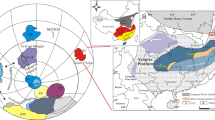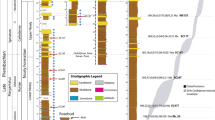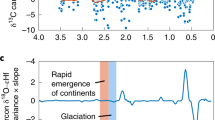Abstract
The marine sedimentary record exhibits evidence for episodes of enhanced organic carbon burial known as ‘oceanic anoxic events’ (OAEs)1,2. They are characterized by carbon-isotope excursions in marine3 and terrestrial4 reservoirs and mass extinction of marine faunas5. Causal mechanisms for the enhancement of organic carbon burial during OAEs are still debated6,7, but it is thought that such events should draw down significant quantities of atmospheric carbon dioxide7. In the case of the Toarcian OAE (∼183 million years ago), a short-lived negative carbon-isotope excursion in oceanic and terrestrial reservoirs has been interpreted to indicate raised atmospheric carbon dioxide4 caused by oxidation of methane catastrophically released from either marine gas hydrates4 or magma-intruded organic-rich rocks8. Here we test these two leading hypotheses4,8 for a negative carbon isotopic excursion marking the initiation of the Toarcian OAE using a high-resolution atmospheric carbon dioxide record obtained from fossil leaf stomatal frequency9,10. We find that coincident with the negative carbon-isotope excursion carbon dioxide is first drawn down by 350 ± 100 p.p.m.v. and then abruptly elevated by 1,200 ± 400 p.p.m.v, and infer a global cooling and greenhouse warming of 2.5 ± 0.1 °C and 6.5 ± 1 °C, respectively. The pattern and magnitude of carbon dioxide change are difficult to reconcile with catastrophic input of isotopically light methane from hydrates5 as the cause of the negative isotopic signal. Our carbon dioxide record better supports a magma-intrusion hypothesis8, and suggests that injection of isotopically light carbon from the release of thermogenic methane occurred owing to the intrusion of Gondwana coals by Toarcian-aged Karoo-Ferrar dolerites.
This is a preview of subscription content, access via your institution
Access options
Subscribe to this journal
Receive 51 print issues and online access
$199.00 per year
only $3.90 per issue
Buy this article
- Purchase on Springer Link
- Instant access to full article PDF
Prices may be subject to local taxes which are calculated during checkout


Similar content being viewed by others
References
Jenkyns, H. C. The Early Toarcian (Jurassic) anoxic event—Stratigraphic, sedimentary, and geochemical evidence. Am. J. Sci. 288, 101–151 (1988)
Arthur, M. A., Dean, W. E. & Pratt, L. M. Geochemical and climatic effects of increased marine organic carbon burial at the Cenomanian/Turonian boundary. Nature 335, 714–717 (1988)
Jenkyns, H. C. Evidence for rapid climate change in the Mesozoic-Palaeogene greenhouse world. Phil. Trans. R. Soc. Lond. A 361, 1885–1916 (2003)
Hesselbo, S. P. et al. Massive dissociation of gas hydrate during a Jurassic oceanic anoxic event. Nature 406, 392–395 (2000)
Harries, P. J. & Little, C. T. S. The early Toarcian (Early Jurassic) and the Cenomanian-Turonian (Late Cretaceous) mass extinctions: similarities and contrasts. Palaeogeogr. Palaeoclimatol. Palaeoecol. 154, 39–66 (1999)
Kerr, A. C. Oceanic plateau formation; a cause of mass extinction and black shale deposition around the Cenomanian-Turonian boundary? J. Geol. Soc. Lond. 155, 619–626 (1998)
Kump, L. R. & Arthur, M. A. Interpreting carbon-isotope excursions; carbonates and organic matter. Chem. Geol. 161, 181–198 (1999)
Svensen, H. et al. Release of methane from a volcanic basin as a mechanism for initial Eocene global warming. Nature 429, 542–545 (2004)
McElwain, J. C. Do fossil plants signal palaeoatmospheric CO2 concentration in the geological past? Phil. Trans. R. Soc. Lond. B 353, 83–95 (1998)
Royer, D. L., Berner, R. A. & Beerling, D. J. Phanerozoic atmospheric CO2 change: evaluating geochemical and paleobiological approaches. Earth Sci. Rev. 54, 349–392 (2001)
Koppelhus, E. B. & Nielsen, L. H. Palynostratigraphy and paleoenvironments of the Lower to Middle Jurassic Bagå Formation of Denmark. Palynology 18, 139–194 (1994)
Michelson, O., Nielsen, L. H., Johannessen, P. N., Andsbjerg, J. & Surlyk, F. in The Jurassic of Denmark and Greenland (eds Ineson, J. R. & Surlyk, F.) 147–216 (Geological Survey of Denmark and Greenland Bulletin, Copenhagen, 2003)
McElwain, J. C., Mayle, F. E. & Beerling, D. J. Stomatal evidence for a decline in atmospheric CO2 concentration during the Younger Dryas stadial: a comparison with Antarctic ice core records. J. Quat. Sci. 17, 21–29 (2002)
Kürschner, W. M. The anatomical diversity of recent and fossil leaves of the durmast oak (Quercus petraea Lieblein Quercus pseudocastanea Goeppert): implications for their use as biosensors of palaeoatmospheric CO2 levels. Rev. Palaeobot. Palynol. 96, 1–30 (1997)
Palfy, J. & Smith, P. L. Synchrony between Early Jurassic extinction, oceanic anoxic event, and the Karoo-Ferrar flood basalt volcanism. Geology 28, 747–750 (2000)
Cleveland, W. S. & Devlin, S. J. Locally weighted regression: An approach to regression analysis by local fitting. J. Am. Stat. Assoc. 83, 596–610 (1988)
Royer, D. L. et al. Paleobotanical evidence for near present-day levels of atmospheric CO2 during part of the Tertiary. Science 292, 2310–2313 (2001)
Jenkyns, H. C., Jones, C. E., Gröcke, D. R., Hesselbo, S. P. & Parkinson, D. N. Chemostratigraphy of the Jurassic System: applications, limitations and implications for palaeoceanography. J. Geol. Soc. Lond. 159, 351–378 (2002)
Bailey, T. R., Rosenthal, Y., McArthur, J. M., van de Schootbrugge, B. & Thirlwall, M. F. Paleoceanographic changes of the Late Pleinsbachian-Early Toarcian interval: a possible link to genesis of an oceanic anoxic event. Earth Planet. Sci. Lett. 212, 307–320 (2003)
Vakhrameev, V. A. Jurassic and Cretaceous Floras and Climates of the Earth (Cambridge Univ. Press, Cambridge, 1991)
Cohen, A. S., Coe, A. L., Harding, S. M. & Schwark, L. Osmium isotope evidence for the regulation of atmospheric CO2 by continental weathering. Geology 32, 157–160 (2004)
Siegenthaler, U. & Sarmiento, J. L. Atmospheric carbon dioxide and the oceans. Nature 365, 119–125 (1993)
Milkov, A. V. Global estimates of hydrate-bound gas in marine sediments: how much is really out there? Earth Sci. Rev. 66, 183–197 (2004)
Veevers, J. J., Powell, C. M., Collinson, J. W. & Lopez-Gamundi, O. R. in Permian-Triassic Pangean Basins and Foldbelts along the Panthalassan Margin of Gondwanaland (eds Veevers, J. J. & Powell, C. M.) 331–353 (Geological Society of America Memoir, Boulder, 1994)
Elliot, D. H. & Fleming, T. H. Occurrence and dispersal of magmas in the Jurassic Ferrar Large Igneous Province, Antarctica. Gondwana Res. 7, 223–237 (2004)
Ballance, P. F. & Watters, W. A. Hydrothermal alteration, contact metamorphism, and authigenesis in Ferrar Supergroup and Beacon Supergroup rocks, Carapace Nunatak, Allan Hills, and Coombs Hills, Victoria Land, Antarctica. NZ J. Geol. Geophys. 45, 71–84 (2002)
Kurtz, A. C., Kump, L. R., Arthur, M. A., Zachos, J. C. & Paytan, A. Early Cenozoic decoupling of the global carbon and sulfur cycles. Paleoceanography 18, 1090–1104 (2003)
Knoll, A. H., Bambach, R. K., Canfield, D. E. & Grotzinger, J. P. Comparative Earth history and Late Permian mass extinction. Science 273, 452–457 (1996)
Beerling, D. J., Lomas, M. R. & Gröcke, D. R. On the nature of methane gas-hydrate dissociation during the Toarcian and Aptian oceanic anoxic events. Am. J. Sci. 302, 28–49 (2002)
Kothavala, Z., Oglesby, R. J. & Saltzman, B. Sensitivity of equilibrium surface temperature of CCM3 to systematic changes in atmospheric CO2 . Geophys. Res. Lett. 26, 209–212 (1999)
Acknowledgements
We thank the Comer Foundation of Science and Education for funding, F. Surlyk for logistical support for fieldwork, I. Glasspool for insights on Karoo basin coal, P. Wagner for statistical assistance, and M. Huber and B. Sageman for critical comments on an earlier version of the manuscript. Scientific discussion with M. Arthur, H.C. Jenkyns and L.R. Kump is also acknowledged. We thank B.S. Cramer for suggestions that greatly improved the manuscript.Author Contributions J.C.M.and J.W.M. were responsible for laboratory data collection. All authors contributed equally to interpretation.
Author information
Authors and Affiliations
Corresponding author
Ethics declarations
Competing interests
Reprints and permissions information is available at npg.nature.com/reprintsandpermissions. The authors declare no competing financial interests.
Supplementary information
Supplementary Table S1
Mean fossil leaf stomatal density (SD) and index (SI) data from the Sorthat Formation, Bornholm, Denmark. (PDF 58 kb)
Supplementary Table S2
Randomly resampled stomatal indices from mesofossil leaves of the Sorthat Formation, Bornholm Denmark. (PDF 50 kb)
Rights and permissions
About this article
Cite this article
McElwain, J., Wade-Murphy, J. & Hesselbo, S. Changes in carbon dioxide during an oceanic anoxic event linked to intrusion into Gondwana coals. Nature 435, 479–482 (2005). https://doi.org/10.1038/nature03618
Received:
Accepted:
Issue Date:
DOI: https://doi.org/10.1038/nature03618
This article is cited by
-
Early Jurassic large igneous province carbon emissions constrained by sedimentary mercury
Nature Geoscience (2024)
-
Orbital pacing and secular evolution of lake-level changes reconstructed by sedimentary noise modeling during the Early Jurassic icehouses-(super)greenhouses
Science China Earth Sciences (2024)
-
The Toarcian Posidonia Shale at Salem (North Alpine Foreland Basin; South Germany): hydrocarbon potential and paleogeography
International Journal of Earth Sciences (2024)
-
The Cenomanian/Turonian boundary in light of new developments in terrestrial palynology
Scientific Reports (2023)
-
Mercury isotope evidence for marine photic zone euxinia across the end-Permian mass extinction
Communications Earth & Environment (2023)
Comments
By submitting a comment you agree to abide by our Terms and Community Guidelines. If you find something abusive or that does not comply with our terms or guidelines please flag it as inappropriate.



